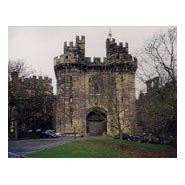Pictured: Lancaster Castle; Lancashire County, England. Photo credit: Joan Shurtliff
“Oyez… oyez… oyez… The court is now in session…”
English courts have been interesting to me. The idea of the lead attorneys and judges wearing robes and funny white wigs is hard to imagine here in the United States. Tradition, though, is important in Great Britain. As a genealogist, British courts are even more interesting because various courts have been handling disputes for hundreds of years, and the records can provide insight for genealogists who want to trace family history.
The earliest courts were called Common Law Courts and were not very efficient, but there is usually more than one way to accomplish a goal. Individuals unhappy with the court system could petition the courts for justice to be done. Consequently, a system of courts to handle the various types of cases evolved.
The most common courts were:
- Court of the Exchequer. To remember the types of cases this court handled, think “cheque” or money. This court usually handled financial cases.
- Court of the Chancery. This court heard civil disputes in England and Wales. As the population grew so did the case load, as the cases were often disputes between family members.
- Court of Common Pleas. This court evolved from the King’s Council in the late 12th Century. Most cases were common law disputes usually concerning debts or land.
- Church Courts. These courts took on moral crimes with decisions made by clergy or parish officers. Their height of power came in the 1500s and early 1600s. As time passed, the types of cases handled by Church Courts decreased to handling marriage licenses and clerical discipline. Most Church Court records are held by County Record Offices (CROs).
- Criminal Courts. This court handled more serious cases. Although the original documents are difficult to read, a number of books have been published containing case and trial reports and information.
The earliest courts were created after the Norman Conquest. Called Eyres, the courts were held in the various manors with the Lord of the Manor acting as judge. By the 1300s, the role of the Lord of the Manor was replaced by Justices of the Peace. The justices heard civil pleas, crown pleas, and received inquests into suspicious or unnatural deaths from coroners.
When the Eyre system ceased to function well, a new system called Assize Courts was created. Dating from the 1300s, circuits were created with judges from the courts at Westminster visiting each county on a regular basis. The earliest role of the judges was to review certain property disputes. The justices’ powers gradually expanded to include criminal cases. Assize Courts were replaced by Crown Courts in 1971. Most Assize records are now at The National Archives (TNA), although many have been lost or destroyed.
The Assize circuits did not include London. Criminal jurisdiction in London was handled by three commissions:
- of the peace
- of gaol (jail) delivery of Newgate
- of oyer and terminer.
Remember, in England people used to be incarcerated for any of a number of offenses. Think Charles Dickens. There are many prison lists, and they can be found in a number of places:
- The census lists people in prison on census night
- The National Archives has prison lists generally covering the years between 1805 and 1892
- County Record Offices
There is one final area of the English court system that may be of interest to the genealogical researcher looking for individuals who died under unusual circumstances. The office of coroner was established in 1194, and until the 1800s most coroners were elected. In 1888, counties were divided into districts, with the coroner becoming an appointed position. Although many of the coroner’s records have been lost or destroyed, those that exist are opened to the public after 75 years. The records are at TNA.
To find your ancestors, don’t forget to check the newspapers. Often court happenings and legal notices were published.
It’s important for family genealogy researchers to remember a couple of things: Many of the early court records, beginning in the late 1300s, are found at TNA, but they are not very well organized, and most are in Latin. Hence, researching them for genealogical information is difficult.
When you are conducting ancestry searches, especially if you are researching British genealogy, don’t limit your genealogical research to just a couple of resources. Expand your ancestry search horizons; put a British genealogy stamp in your family search genealogy passport to find your ancestors. Try new avenues. Do what professional genealogists do and tap alternative databases, court records, legal notices, newspapers, et al. Do what genealogy ancestry services do when they trace family history – get creative. If you do hit a stumbling block, consider reaching out to a genealogical service. RecordClick is a full-service genealogy ancestry service with professional genealogists living and working in Great Britain.
Joan Shurtliff is a board certified genealogist. She is a member of the South Dakota Genealogy Society (SDGS), where she received the Outstanding Member Award for 2011. She currently serves as a Quarterly Editor for the SDGS. Ms. Shurtliff has ties to several early settlers and 1870 Nebraska homesteaders.







